TOP 10 activities to do in Essaouira
Essaouira, a charming port city located on Morocco’s Atlantic coast, boasts a rich and fascinating history. The area has been inhabited since prehistoric times, as evidenced by archaeological research. Over the centuries, Essaouira has experienced various influences and events that have shaped its unique identity.
In the 18th century, Essaouira underwent significant development, becoming a fortified city built according to contemporary European military architecture principles. This transformation gave rise to the city’s distinctive and well-preserved medina, now recognized as a UNESCO World Heritage Site. In the 19th century, Essaouira—then known as Mogador—witnessed a key event known as the Bombardment of Mogador in August 1844. This occurred during the French protectorate era in Morocco, when Essaouira was under French control from 1912 to 1956.
Today, visitors can explore Essaouira’s historic medina and discover its architectural treasures, such as the Skala de la Ville, a picturesque seaside rampart, and the famous Moulay Hassan Square. The city’s history is also reflected in its traditional craftsmanship, including woodcarving, silversmithing, and carpet weaving.
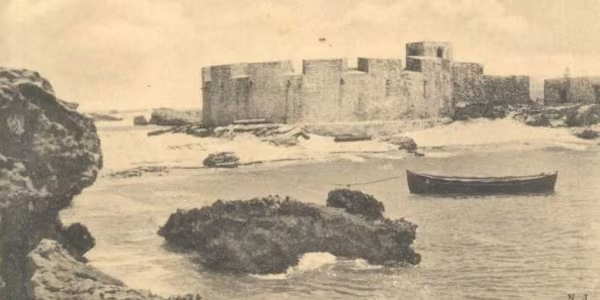
Top 10 Things to Do in Essaouira
Essaouira, nicknamed the "Pearl of the Atlantic Coast," is one of the most popular tourist destinations in Morocco. This coastal city charms travelers with its picturesque appeal, laid-back atmosphere, and rich cultural heritage. The golden sandy beaches provide the perfect setting for relaxation, water sports, and enjoying fresh seafood. The historic medina, listed as a UNESCO World Heritage Site, is filled with narrow alleys, bustling souks, and architecture influenced by both Andalusian and European styles. Visitors can explore iconic sites such as the impressive city walls, the picturesque port, local craft shops, and art galleries. Essaouira is also famous for its Gnaoua Music Festival, which attracts artists from around the world. Its relaxed vibe, flavorful cuisine, and the warm hospitality of its people make it a must-visit destination for those seeking to experience Morocco’s cultural diversity and natural beauty. Whether traveling solo, with friends, or with family, your trip to Essaouira will be a truly unique experience.
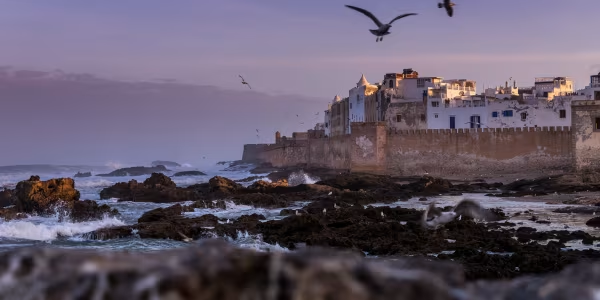
To fully enjoy your trip to Essaouira, it is recommended to rent a car from Thrifty Maroc via their website and pick it up at our Essaouira airport agency. Choosing this option will allow you to thoroughly explore nearby and more distant tourist activities from the moment you arrive, maximizing your sightseeing opportunities during your trip to Essaouira.
1- The Medina of Essaouira: A Journey Through Time and Authenticity
We begin this top 10 guide with the Medina of Essaouira, one of Morocco’s architectural jewels. Located on the Atlantic coast, this ancient fortified city is a UNESCO World Heritage site. The medina is surrounded by imposing ramparts built in the 18th century. Its narrow, winding streets invite visitors to get lost in a maze of charming whitewashed houses, artisanal shops, and traditional restaurants.
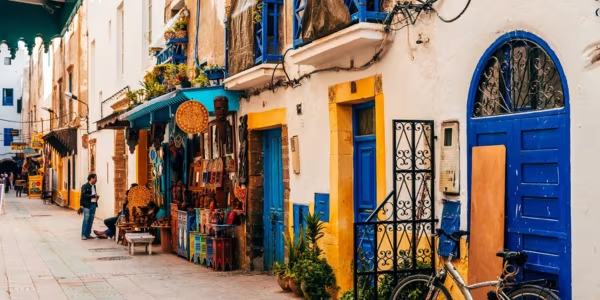
One of the highlights of the Essaouira medina is the Skala de la Ville, a seaside fortification that offers a breathtaking view of the ocean. From there, you can watch local fishermen at work and admire the colorful boats. The medina is also home to many souks, where you can immerse yourself in the lively market atmosphere. You'll find a wide variety of handcrafted goods, such as Berber rugs, leather items, jewelry, and ceramics.
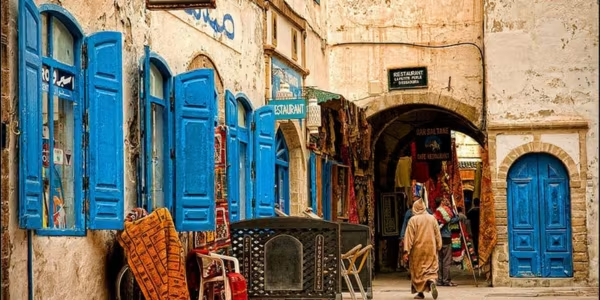
But the old town of Essaouira is not only known for its architecture and historical heritage. It is also renowned for its relaxed and artistic atmosphere. The city has attracted many artists and musicians, which is reflected in its art galleries and cultural festivals. As you stroll through the alleys of the medina, you’ll be enchanted by its timeless charm and bohemian vibe. Essaouira is a must-visit destination for travelers seeking authenticity, history, and culture.
2- Place Moulay Hassan in Essaouira: A Crossroads of Culture and Entertainment
Place Moulay Hassan is a popular meeting point for both locals and tourists. It is named after Sultan Moulay Hassan, who ruled Morocco in the 19th century. The square is surrounded by numerous shops, as well as cafés and terrace restaurants, making it a perfect spot to relax, socialize, and enjoy the vibrant atmosphere of the city.
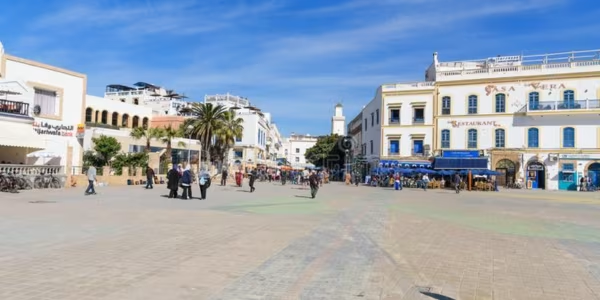
At the center of the square stands the Essaouira Mosque, also known as the Moulay Hassan Mosque. This impressive mosque is a stunning example of traditional Moroccan architecture, featuring an elegant minaret and exquisite decorative details. Visitors can admire its beautiful exterior and feel the serenity of this sacred place. Nearby, you’ll find the Governor’s Palace, a historic building that reflects the royal past of the city. Although the palace is not open to the public, its majestic architecture and ornate doors are well worth a look.
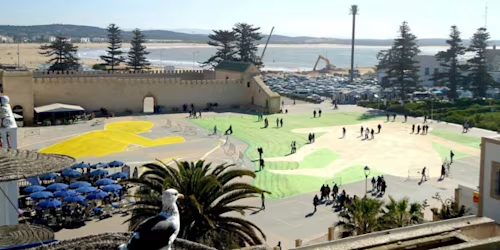
The square is also the venue for numerous events and festivals held throughout the year. Music, dance, and art festivals attract local and international artists, creating a joyful and creative atmosphere in the square. As you stroll through Place Moulay Hassan, you can soak up the daily life of Essaouira. You'll see colorful stalls run by street vendors, hear street musicians playing traditional Moroccan tunes, and observe locals gathering to chat and enjoy the lively ambiance.
3 - The Port of Essaouira: A Haven of Freshness and Authenticity
The Port of Essaouira is one of the true gems of this Moroccan coastal city. Nestled along the shores of the Atlantic Ocean, this historic harbor is an iconic spot offering visitors an authentic and picturesque experience. Formerly known as Mogador, the port was constructed in 1769 during the reign of Sidi Mohammed. It played a vital role in maritime trade between Africa, Europe, and the Americas. Today, the port is mainly used by local fishermen, who set out to sea daily to bring back fresh catches.
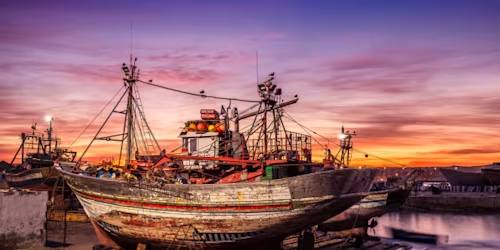
The colorful scene at the port is a sight to behold. The blue and white fishing boats, known as "blue boats", are moored along the dock, creating a striking contrast with the ocean and the sky. Fishermen bustle around their nets, sorting the day’s catch, while seagulls soar above, hoping to snatch a bite of fish. As you stroll along the port, you’ll have the chance to admire the lively activities taking place. You can watch the fishermen repairing their nets, enthusiastically chatting about the latest catches, or negotiating with buyers looking for fresh fish. The atmosphere is filled with the salty scent of the sea, the calls of seabirds, and the buzz of lively conversations.
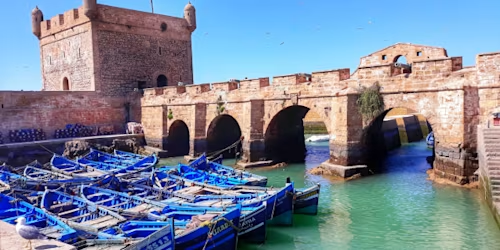
The port of Essaouira is not limited to fishing activities. It also hosts several restaurants where you can enjoy fresh and flavorful seafood dishes, prepared with fish straight from the fishermen’s nets. It’s the perfect place to taste local culinary specialties and indulge in delicious marine flavors. In addition to its picturesque charm, Essaouira’s port boasts a rich history and captivating architecture. The old gates still surround the port, bearing witness to its strategic importance in the past. You can also find historic landmarks such as the Skala of the Port of Essaouira, a defensive tower built by Christian prisoners in the 19th century.
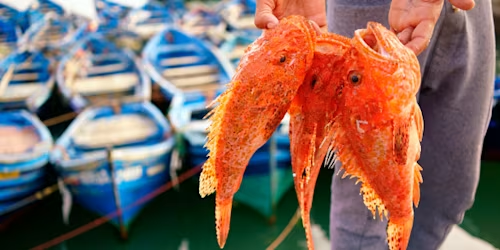
The fishing port of Essaouira is a place of encounters, discovery, and wonder. Whether you're a seafood lover, a history enthusiast, or simply seeking an authentic experience, this port will captivate you with its beauty and unique atmosphere.
4 – The Ramparts of Essaouira: Majestic Witnesses of History and Coastal Beauty
The ramparts of Essaouira are one of the most iconic features of this coastal Moroccan city. Built in the 18th century, these impressive walls surround the medina, offering breathtaking views of the Atlantic Ocean and preserving the city's historical charm. The ramparts were designed by the renowned French architect Théodore Cornut in the defensive military style of the time. They were constructed to protect the city from maritime attacks and to serve as fortifications against invaders. The massive stone walls, reinforced by bastions and watchtowers, are a testament to their defensive purpose.
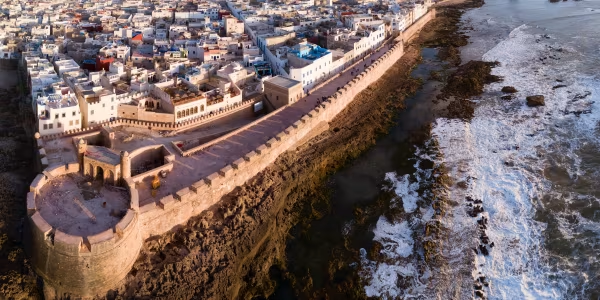
As you stroll along the ramparts, you can admire the panoramic view of the sea and the beaches stretching as far as the eye can see. The rampart openings, once used for cannons, are now perfect viewpoints for watching the crashing waves and enjoying a breathtaking sunset on the horizon. The ramparts of Essaouira also invite you to lose yourself in the narrow alleys of the medina. As you walk along the walls, you’ll discover traditional craft shops, art galleries, lively cafés, and restaurants serving delicious local dishes. Every street corner offers a new surprise—a unique visual and sensory delight.
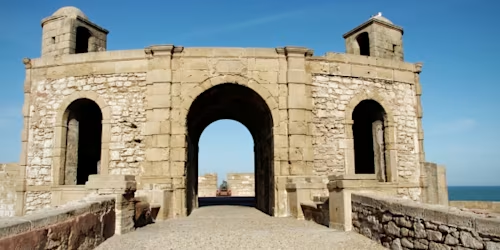
Another point of interest along the ramparts is the famous Marine Gate, one of the main entrances to the medina. It was once the passage through which goods were transported from the port to the rest of Essaouira. Today, it is a lively spot where visitors and locals cross paths, creating a vibrant and authentic atmosphere. The ramparts of Essaouira have also played a significant role in the city’s history and heritage. They were inscribed as a UNESCO World Heritage Site in 2001 for their historical and architectural value.
5 - The Souks of Essaouira: A Magical Journey into Moroccan Craftsmanship
The souks of Essaouira are a true treasure trove of Moroccan craftsmanship and offer an authentic shopping experience. Located in the heart of the medina, these traditional markets are filled with vibrant colors, enchanting aromas, and artisanal wonders. You'll find a variety of local products—from beautifully woven Berber carpets and finely crafted silver jewelry to the famous thuya wood items, characteristic of the region. Essaouira’s main souk is also well-known for its leather goods, colorful fabrics, pottery, and exotic spices. The lively ambiance of the souk is a feast for the senses. You’ll be captivated by the colorful stalls, enthusiastic vendors, and spirited bargaining. Don’t hesitate to haggle for the best price—it’s an essential part of the souk culture in Morocco.
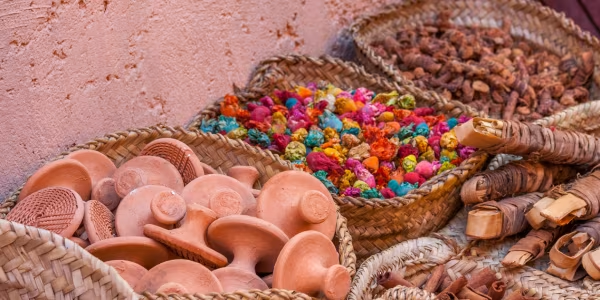
As you wander through the souk of Essaouira, you’ll also have the chance to discover local art and craftsmanship. Many artisans work directly in their workshops, allowing you to witness the creation of unique pieces and even take part in demonstrations of traditional skills. Beyond shopping, the souks of Essaouira are also a perfect place to experience the daily life of the local population. You’ll meet warm and welcoming locals, taste delicious regional culinary specialties, and immerse yourself in the vibrant atmosphere of this historic setting.
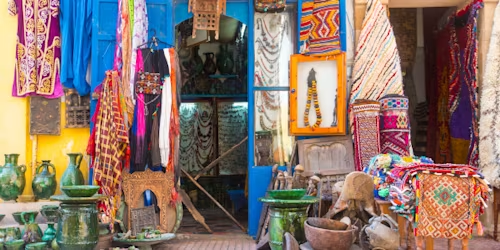
Whether you're seeking unique souvenirs, artistic items, or simply an immersive cultural adventure, the souks of Essaouira are an essential stop during your visit to this enchanting Moroccan town.
6 – The Simon Attias Synagogue: A Historical Gem of Essaouira’s Jewish Heritage
The Simon Attias Synagogue is a 19th-century synagogue located in Essaouira, formerly known as Mogador, Morocco. Also referred to as Bet El Synagogue or Slat Al Fassiyine, it stands as one of the most prominent Jewish landmarks in the city.
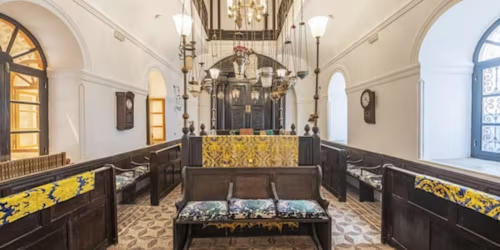
The Simon Attias Synagogue is located within the Bayt Dakira, the House of Memory. This beautifully restored museum traces the history of the Jewish community and their significance in the region. It consists of a three-story historic house including shops, the private residence of Nima Attia on the first floor, a prayer hall on the second floor, and a community room on the third floor. The Simon Attias Synagogue is renowned for its architecture and spiritual atmosphere. It was built from cedar wood by the Jewish merchant Simon Attias in 1882. The interior of the synagogue emits a captivating scent of cedar wood and provides a peaceful and sacred space for prayer.
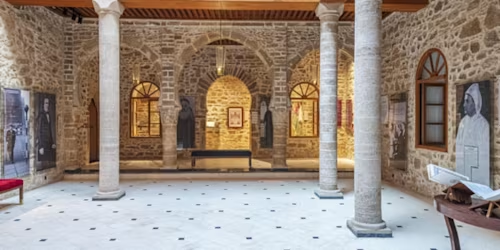
The Simon Attias Synagogue stands as a living testimony to Essaouira’s Jewish history and is an important site for preserving Moroccan Jewish memory. It attracts visitors from around the world who come to admire its magnificent architecture and learn more about the culture and traditions of the Jewish community in the region.
7- The Gnaoua Festival of Essaouira: World Music
The Gnaoua Festival of Essaouira is an annual music event held in the beautiful coastal city of Essaouira, Morocco. It is one of the country’s most iconic festivals, highlighting traditional Gnaoua music and its influence on the global music scene. Founded in 1998 by Moroccan artists, the festival has since become a must-see event for world music enthusiasts worldwide. It showcases the richness and diversity of Gnaoua music, a unique fusion of African, Berber, and Arab traditions.
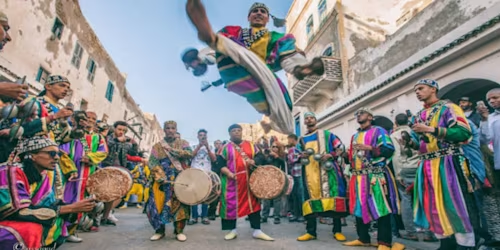
During the festival, Essaouira’s old medina transforms into a true hub of musical celebration. The streets resonate with the enchanting sounds of Gnaoua musicians, accompanied by international artists from diverse musical backgrounds.
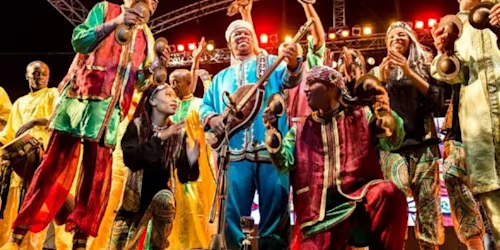
In addition to concerts, the festival also offers workshops and conferences where visitors can learn more about the history, traditions, and instruments of Gnaoua music. It is a unique opportunity to immerse oneself in Moroccan culture and experience a musical journey. The Essaouira Gnaoua Festival is internationally recognized and attracts thousands of visitors each year who come to lose themselves in the intoxicating and vibrant rhythms of Gnaoua music.
8- Essaouira: Discover the Argan Oil Cooperatives, Symbols of Tradition and Female Empowerment
Essaouira, Morocco, is renowned for its argan oil cooperatives where local women produce this precious oil from the nuts of the argan tree. Among the well-known cooperatives in Essaouira is the Argan Marjana Cooperative, which offers demonstrations of argan oil production and allows visitors to purchase products directly on site.
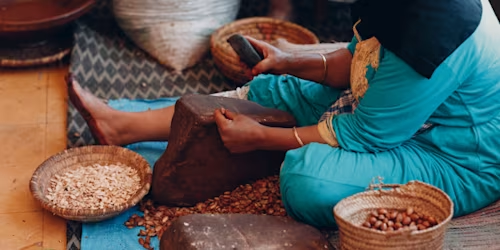
The Tilila Women’s Argan Oil Cooperative is also highly regarded. Located just a few kilometers from Essaouira, it offers visitors the opportunity to purchase high-quality argan oil directly from the women who produce it.

Another notable cooperative is the Kaouki Cooperative, specializing in the production and marketing of natural and organic products, particularly argan oil. These cooperatives support local women who work hard to preserve this artisanal tradition and offer visitors a chance to learn about the argan oil production process. Buying argan oil directly from these cooperatives is often preferable to purchasing in tourist shops, as it ensures the product's authenticity and quality.
9- La Kasbah Gallery in Essaouira
La Kasbah Gallery is a prestigious art venue located in a beautifully restored 18th-century riad. The gallery showcases a diverse and high-quality range of art exhibitions, highlighting various artistic styles. Known for its collection of artworks and antiques, it offers visitors an enchanting artistic experience. Visitors can admire the exhibitions, explore the beautifully arranged building, and enjoy a relaxed atmosphere. La Kasbah Gallery is open daily from 9 AM to 9 PM, providing art lovers a unique cultural stop during their stay in Essaouira.
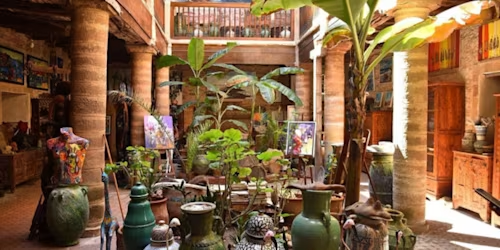
10- Real Mogador art centre in Essaouira
The Real Mogador Art Center is an artistic venue located in the medina of Essaouira, Morocco. Formerly the Italian consulate, this authentic and magnificent riad has been transformed into a space dedicated to contemporary creation. The building features unique architecture that was enhanced and colorfully restored after its acquisition. The Real Mogador Art Center offers installations and exhibitions showcasing both local and international artistic creations. It is a place where artists can reside and work, thus promoting artistic and cultural exchanges.
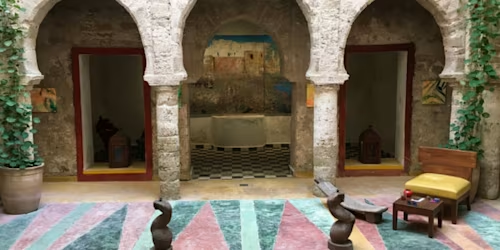
Visitors can discover contemporary artworks in an enchanting setting in the heart of Essaouira’s medina. The Real Mogador Art Center offers a unique artistic experience, allowing art lovers to immerse themselves in the local scene and discover emerging talents.
Discover the magnificent beach of Essaouira
We conclude our guide with the magnificent Essaouira beach, a natural gem on Morocco’s Atlantic coast. Its miles of golden sand stretch as far as the eye can see, offering a spectacular backdrop between the Atlantic Ocean and Essaouira’s medina. This beach captivates with its wild and preserved beauty.
A paradise for water sports and surfing
Essaouira beach is a true paradise for water sports enthusiasts. Thanks to the steady winds and powerful Atlantic waves, it is ideal for surfing, kitesurfing, and windsurfing. Numerous water sports schools offer lessons for beginners as well as equipment rental for enthusiasts.

The Relaxed Atmosphere:
What sets Essaouira beach apart is its relaxed atmosphere. Unlike some overcrowded beaches, Essaouira offers space and tranquillity. Visitors can lie on the sand, sunbathe or stroll along the beach in complete peace and quiet. It's the ideal place to recharge your batteries.
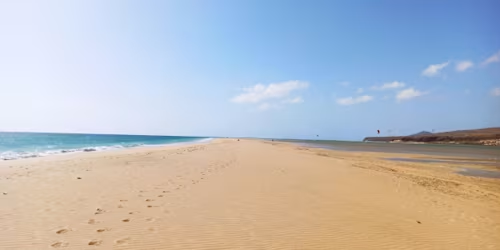
A wide range of activities:
As well as water sports, Essaouira beach offers a wide range of activities. You can go horse riding along the shore, fishing from the jetty or even opt for a camel ride for a typical Moroccan experience. Local vendors sell souvenirs and refreshments to enhance your day.
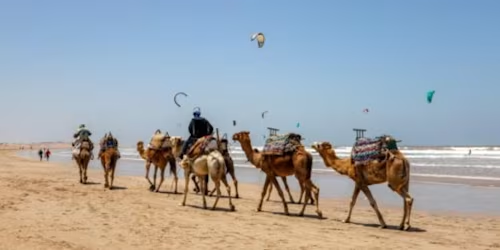
The Complement to the Medina:
One of the advantages of Essaouira’s beach is its close proximity to the UNESCO World Heritage-listed medina. After a day at the beach, visitors can easily explore the old medina, its historic ramparts, lively souks, and restaurants serving excellent fresh seafood.
Other places to explore near Essaouira:
Riads
Chichaoua, not far from Essaouira
Marrakech